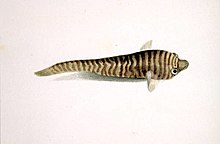The New Zealand urchin clingfish is a clingfish. It is found around New Zealand wherever sea urchins are present. Its length is between 2 and 3 cm.
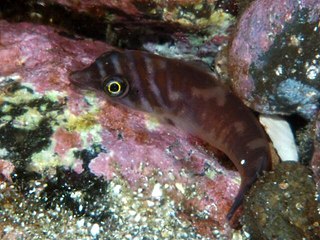
Clingfishes are fishes of the family Gobiesocidae, the only family in the order Gobiesociformes. These fairly small to very small fishes are widespread in tropical and temperate regions, mostly near the coast, but a few species in deeper seas or fresh water. Most species shelter in shallow reefs or seagrass beds, clinging to rocks, algae and seagrass leaves with their sucking disc, a structure on their chest.
The Slender clingfish, Gastrocyathus gracilis, is a clingfish of the family Gobiesocidae, the only species in the genus Gastrocyathus. This species grows to a length of 4.5 centimetres (1.8 in) TL. Endemic to New Zealand, this species is apparently only found in beds of strap-fronded algae. Harpacticoid copepods comprise the main component of their diet.
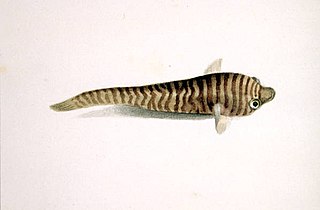
The Tasmanian clingfish is a clingfish of the family Gobiesocidae, found around the western and southern coasts of Australia including Tasmania. Its length is up to 8 cm. This species is found in shallow, coastal, rocky reefs and in the intertidal zone. It is also encountered by scuba divers beneath piers and jetties.

Apletodon is a genus of marine fish in the family Gobiesocidae (clingfishes). The genus was first named by John Carmon Briggs in 1955.

Arcos is a genus of clingfishes.

Cochleoceps is a genus of clingfishes endemic to the waters around Australia.
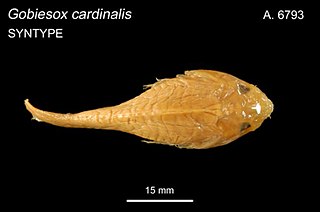
Creocele cardinalis, the broad clingfish, is a species of clingfish found on the southern coast of Australia.
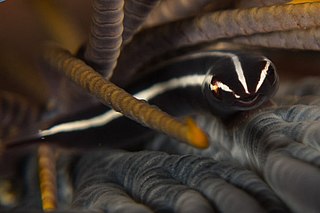
Discotrema is a genus of clingfishes found on reefs in the Indo-Pacific where they live on crinoids. These tiny fish have distinctive pattern consisting of long white or yellow lines along their body.

Gobiesox is a genus of clingfishes found in the Americas, including offshore islands. Most species inhabit coastal marine and brackish waters, but G. lanceolatus is a deep-water species found at a depth of around 300 m (980 ft), and seven species are from fast-flowing rivers and streams. These seven are the only known freshwater clingfish.

Kopua is a genus of clingfishes found in the Pacific Ocean.
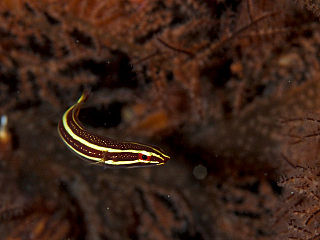
Lepadichthys is a genus of clingfishes native to the Indian and Pacific Oceans.
Pherallodiscus is a genus of clingfishes native to the central eastern Pacific Ocean along the coast of Mexico. Based on genetic studies the genus should be merged into Gobiesox.
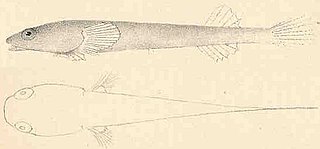
Rimicola is a genus of clingfishes found along the coasts of the eastern Pacific Ocean.

Tomicodon is a genus of clingfishes native to the Western Hemisphere, with these currently recognized species:
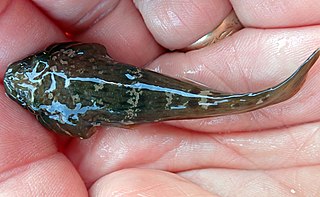
Trachelochismus is a genus of clingfishes endemic to the shores of New Zealand, with currently three recognized species in this genus:
Unguitrema nigrum, also known as the Black crinoid clingfish is a species of clingfish endemic to Papua New Guinea. This species occurs Madang Lagoon in Madang District, Madang Province, Papua New Guinea. This species is the only known member of its genus. It was collected from a crinoid, Oxycomanthus bennetti, of the black phase.

Diplecogaster bimaculata, the two-spotted clingfish, is a species of fish in the family Gobiesocidae found in Black Sea, Mediterranean Sea and Atlantic Ocean where it is found on rocks and among seagrass or shell beds.
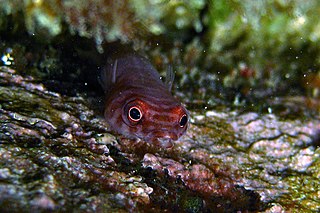
Aspasmogaster costata, the eastern clingfish or pink clingfish is a species of clingfish from the family Gobiesocidae. It is endemic to eastern Australia where it occurs from Byron Bay to the Nadgee Nature Reserve in southern New South Wales and also on Lord Howe Island in the Tasman Sea. This is a secretive species which frequently hides under rocks, shelters in crevices or behind sea urchins at depths down to 20 metres (66 ft). The species was described in 1885 by James Douglas Ogilby with a type locality of Shark Reef near Port Jackson in New South Wales.
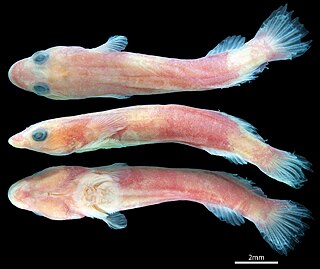
Flexor is a genus of clingfish from the family Gobiesocidae. It is a monotypic genus, the sole member of which Flexor incus was described in 2018 by Kevin W. Conway, Andrew L. Stewart and Adam P. Summers from type specimens collected on Raoul Island and L’Esperance Rock in the Kermadec Islands. An unknown species of clingfish was known to occur in the Kermadecs and it had been provisionally assigned to the genus Aspasmogaster but when examined the specimens proved to belong to a new genus which they name Flexor in reference to the flexibility of clingfishes and incus which means "anvil", a reference to the anvil like shape of the type locality, Raoul Island.
